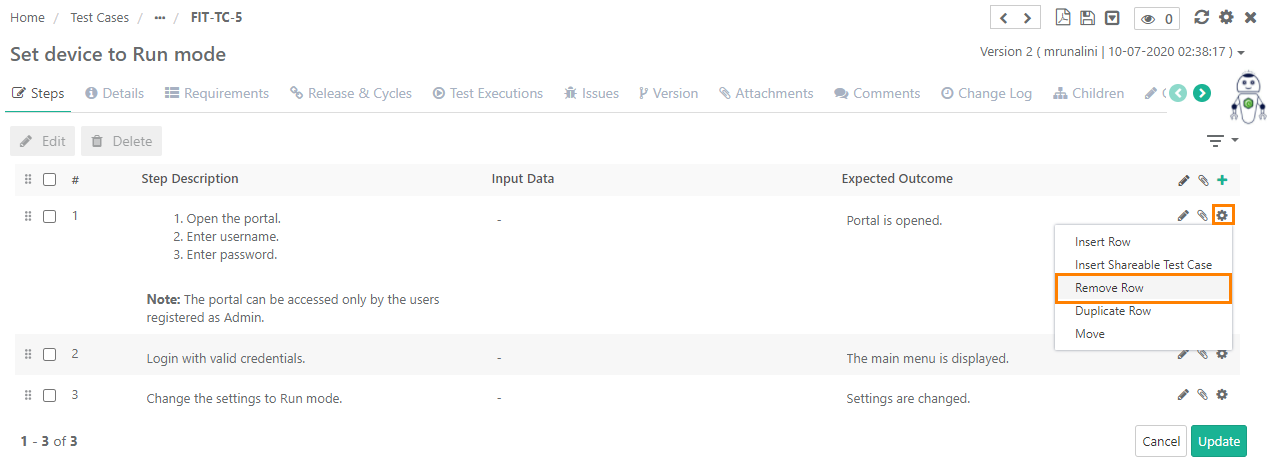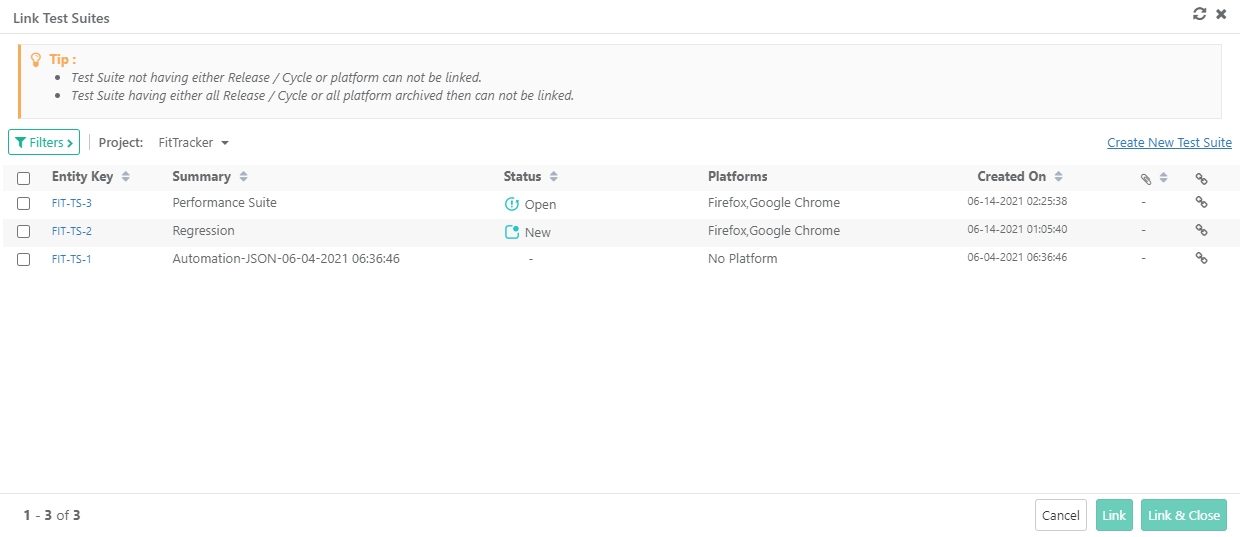| Table of Contents | ||
|---|---|---|
|
...
Show More Columns: The ability to add columns in the view. If there are other columns that you think important to display on the module grid apart from the default view, then you can just select those columns to add them to the view.
Hide Columns: The ability to remove a column from view. If you do not want to include columns of less important on the module grid view, then remove column selection to hide those columns on the view.
Users can show/hide the Testing Type field in the Test Case module. If users want to use their own UDF instead of this field, they can hide it. The setting is provided in the Manage Fields section of the Customization module. Refer to Manage Fields for more details.
Re-arrange: The ability to arrange the columns in a different order through drag and drop functionality.
...
Users can easily filter test assets by any system/custom fields on all module grids. It also helps users in carrying out bulk operations. Filters placed horizontally above the grid earlier, are now placed on the tree panel at left.
Testers can view details grid aligned with folder tree even when they are clicking a folder which is at the bottom.
Apply Filter
Users can apply basic as well as advanced filters to the records.
...
Note: To enable rich text editor, the Enable Rich Text parameter should be enabled for the Project (Projects > Project / Release / Cycle). Refer to Enable Rich Text Editor for more details.
...
Testing Type: You can see this field on the test case detail page once a test case is created. The field shows how the test case was created in QMetry: Manual or Automated. If a test case is created through UI or imported from Excel, then it is identified as a manual test case. Test Cases that are created through Automation APIs are identified as Automated test cases. The Testing Type field remains read-only.
User Defined Fields: If UDFs are added for the test case module, then they are displayed on the Create Test Case screen and Test Case Details screen.
...
On the Test Case Step(s) grid, click the Cog icon for the step you want to remove.
Select Remove Row.
Click Update.
...
→ Delete/Remove Test Steps in Bulk
...
Note: QMetry allows you to use different versions of a test case for testing. Read more about it on the Managing Test Case Versions page.
Archiving a Test Case
All the versions of the test case should be archived to delete that particular test case.
Archiving Entire Test Case
...
To delete a test case, first you need to archive it. All the versions of the test case should be archived to delete that particular test case.
It is a two step process:
...
Deleting Entire Test Case
All the versions of the test case should be archived to delete that particular test case.
A. From Test Case detail page
...
If requirements from other project projects are linked, then the requirements show Entity Key of the corresponding project.
To view the requirement of other projectprojects, click on the Requirement Entity Key. It opens the requirement detail page in the respective project and will change your current project.
...
The feature allows you to link the latest version of the requirement to a test case using the requirement key separated by a comma. Maximum 500 entities can be linked at a time.
...
Requirement key will be ignored if a relevant requirement with that key is not found.
If a single key is mentioned multiple times, it will be linked only once.
If an older version of the requirement is already linked and you are linking the same requirement key, then the latest version will not replace the older version. It will be skipped.
Archived versions will be skipped from linking. Only the latest unarchived version of entities will be linked.
...
How to Unlink Requirements Linked to a Test Case
Open the the Requirements tab on the test case details page.
...
B. To unlink multiple requirements, select the requirements you want to unlink from the test case and click on the Unlink Selected button.
...
You can link test suites with relevant test cases for testing. QMetry allows users to link test suites of multiple projects to a test case. Test Suites can be linked to test case cases through the Test Executions tab available on the Test Case details page and Test Case edit screen.
Test Suites are linked to the test case in multiple of Platforms associated with it.
...
Open the Test Executions tab and Click on the Link Test Suites button. It opens Link Test Suites pop-up.
If you want to link test suites from multiple projects, then first select one project. Search records and link them before moving to other projects. For example, User A is in Project 1 and searches for some records and link links them before moving to Project 2. Else, all the selection of Project 1 will be wiped off.
A. Linking a Single Test Suite: Click on the Link icon to link the individual test suite to the test case.
...
All scenarios mentioned above also apply to the bulk operation of test cases.
...
Test Suites key will be ignored if relevant test suite with that key is not found.
If a single key is mentioned multiple times, it will be linked only once.
Archived test suites will be skipped from linking. Only unarchived version of entities will be linked.
Skip Duplicate Linkage is "On": If the test case is already linked with a test suite, then the linked test suite will be skipped. Only those test suites will be linked which are not yet linked with the test case version from where the linking is being performed.
Skip Duplicate Linkage is "Off": The test case version from where the test suite is being linked, that version will get linked to all the test suites.
Steps
1. Go to the Test Executions tab of the test case.
...
Test run logs to test case are attached at the test run level. These logs are available to view and download on the Test Executions tab of the test case details page. If a test suite has an attachment(s) attached to it, then the Attachment icon is displayed in Blue color for that test suite. Only test case level attachments will be displayed here.
The attachments at the test run level are displayed to provide more in-depth information on test case execution. Users can get the execution details of the test case on the same screen.
...
Release and Cycle can be associated from the test case detail page as well as the test case edit page.
The tab allows users to associate release and cycle to the test case. One test case can be associated with multiple releases and cycles. Release and Cycles are added from Projects > Project/Release/Cycle.
Once the test case is added, the user wants to add it to a particular Scope - release and cycle. For this reason, they edit the test case and associate the new release and cycle to it.
...

